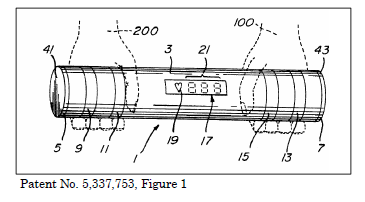U.S. Supreme Court Changes Test for Indefiniteness of a Claim
August 7, 2015
Biosig Instruments Inc. v. Nautilus Inc.
FACTS:
Biosig owns U.S. Patent No. 5,337,753 (the ‘753 patent).
Claim 1 of the ‘753 patent recites in relevant part:
1. A heart rate monitor for use by a user in association with exercise apparatus and/or exercise procedures, comprising:
an elongate member;
electronic circuitry including a difference amplifier having a first input terminal of a first
polarity and a second input terminal of a second polarity opposite to said first polarity;
said elongate member comprising a first half and a second half;
a first live electrode and a first common electrode mounted on said first half in spaced
relationship with each other;
a second live electrode and a second common electrode mounted on said second half
in spaced relationship with each other;
said first and second common electrodes being connected to each other and to a point of
common potential . . .

The live electrodes are identified by numbers 9 and 13. The common electrodes by 11 and 15.
CASE HISTORY:
Biosig sued Nautilus for infringement.
After claim construction, Nautilus filed a motion for summary judgment seeking to have the ’753 patent held invalid for indefiniteness.
The district court granted Nautilus’s motion, holding that the claim term “spaced relationship” is indefinite. Biosig appealed.
The CAFC found the claim is not invalid for indefiniteness, on the basis that the meaning of the phrase “spaced relationship” is not indefinite. The CAFC applied its established test that a claim term is indefinite “only when it is ‘not amenable to construction’ or ‘insolubly ambiguous’. The CAFC considered that one skilled in the art would be able to understand the meaning of the term based upon the intrinsic evidence, i.e. the claim language, specification, figures and prosecution history. The CAFC reversed and remanded for further proceedings.
Nautilus petitioned for certiorari. The Supreme Court granted cert.
The Supreme Court vacated and remanded the CAFC decision in a 9-0 opinion. The Court held that the test for indefiniteness applied by the CAFC is too lenient. The Court held that to tolerate imprecision just short of that rendering a claim “insolubly ambiguous” would diminish the definiteness requirement of the law and fail to give the public sufficient notice of the patent scope. The Court set forth a stricter standard for claim indefiniteness, that a patent claim must inform those skilled in the art with “reasonable certainty” of what is claimed.
On remand, the CAFC maintained the reversal of the district court’s determination that Biosig’s patent claims are indefinite. The CAFC held that one skilled in the art would be able to understand the meaning of the phrase with “reasonable certainty” based upon the intrinsic evidence, i.e. the claim language, specification, figures and prosecution history.
OUTCOME:
The test for indefiniteness is changed. A claim is indefinite when one skilled in the art cannot understand the meaning and scope of the claim with “reasonable certainty”.